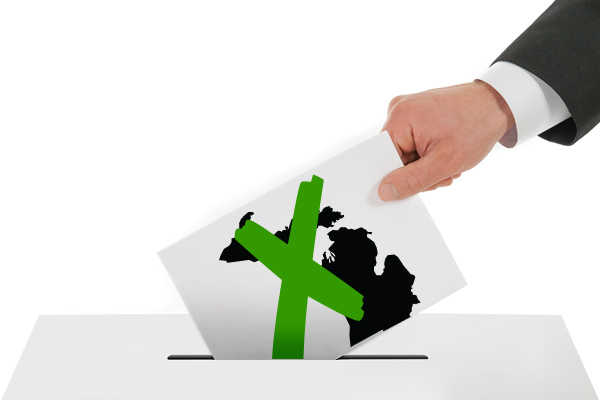
A few months ago, I called Michigan’s Proposition 3, which would have amended the state constitution to raise the state’s renewable energy standard to 25 percent by 2025, “the most important clean-energy vote this year.”
On Tuesday, Prop 3 went down in grisly, spectacular defeat, last reported losing 63 to 37 percent. That’s quite a romp. What went wrong? Does this mean voters don’t like renewable energy?
Probably not. But it does mean that dirty energy has access to a firehose of money that can overwhelm an electorate’s preference for clean energy, seemingly without much difficulty.
Opposing money wasn’t the only obstacle for Prop 3, of course. Five of the six initiatives on the ballot — the five aiming to amend the state constitution — were rejected by similar margins. It may be that Michigan voters simply became suspicious of all efforts to meddle with the constitution.
And it may be that they got sick of outside money flooding the state. Some $141 million was spent on ballot initiatives in the state this year — more than was spent on all Michigan races combined in 2010 — and from all reports the advertisements were incessant and annoying.
So voters were overwhelmed and irritated. Background conditions were not good. In terms of Prop 3 specifically, it was the second most expensive initiative. The spending contest came down to greens vs. utilities and their allies. Greens — including the Michigan League of Conservation Voters (the leading contributor, with $3.1 million), the national League of Conservation Voters, the Green Tech Action Fund, the Blue Green Alliance, and the American Wind Energy Association — poured unprecedented amounts of money into the fight.
And they were easily outspent, by more than two to one, by Michigan’s big utilities. Consumers Energy and DTE Energy dropped around $11.5 million each.
Green groups didn’t do much to publicize their work on this campaign, since part of the negative perception in the state was that outside groups were trying to usurp Michigan energy policy, but behind the scenes they worked hard on it. It wasn’t just the money — they held phone banks in which a good dozen green groups participated; tons of work was done mobilizing the youth vote; endorsements came in from Bill Clinton and former Gov. William Milliken (R).
Yet a flood of dirty-energy money simply swamped those efforts, driving voter approval from 49 percent to 39 percent in a single month. The utilities didn’t even break a sweat.
I’m sure there were messaging and organizing errors too — the 25×25 campaign got defined by its enemies early on, and never defined their enemies in return — but it really looks like this was a money thing.
As the federal level has gotten gummed up, I’ve often said that the road to success on clean energy is through the states. After all, it’s the state renewable energy standards (RESs) that have done most of the grunt work getting renewable energy on the ground in the U.S. Why not just go state by state, building the clean energy industry from the ground up?
The experience of Prop 3 is enough to give pause to that line of thought. It’s hard to see how greens can keep up when dirty energy can muster enough money to carpet bomb a state at will.
And have no doubt: The forces of dirty energy know the action is in the states and they are gearing up to do a carbon-fueled Sherman’s March. The American Legislative Exchange Council (ALEC), a Koch-funded right-wing advocacy group, came up with “model legislation” to yank states out of regional carbon-trading programs and shopped it around to states with newly Republican governors last year. This year they are at it again, pushing model legislation to repeal state RESs. They call it a “high priority.”
ALEC’s claims — that RESs raise energy prices, crush freedom, etc., etc. — are bogus, but they have a lot of money. And as of this week’s elections, there are at least 30 Republican governors in the U.S., more than either party has held for over 12 years. For example, North Carolina, which passed its first, tentative RES in 2008, just got its first Republican governor in 20 years, Pat McCrory, who spent his race flirting with Tea Partiers. What will he do when ALEC runs its “Electricity Freedom Act” through North Carolina’s conservative legislature and it ends up on his desk?
The action is in the states. And the folks behind the Michigan clean-energy push aren’t giving up. But do green groups have the power to win those battles in the face of effectively unlimited fossil-fuel money?
This post is part of our November 2012 theme: Post-election hangover — whither the climate?


